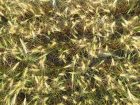
Features
Agronomy
Cereals
Optimizing wheat production
Sometimes you need to take a fresh look to see if the way you’ve done things in the past is still the best way for today’s conditions. Over the past two decades, Manitoba growers have seen changes like rapidly rising soybean acres, increasing problems with herbicide-resistant weeds, and ongoing crop varietal improvements.
November 13, 2018 By Carolyn King
With that in mind, a University of Manitoba project is assessing crop rotations, row spacings and seeding rates to find the optimal choices to maximize wheat yields in current production systems.
Rob Gulden, an associate professor at the University of Manitoba, is leading the project. He is interested in crop spatial arrangements because of their influence on things like crop competitiveness with weeds, disease, lodging and yields.
“We are revisiting row spacing and seeding rate questions for several crops. This wheat project is part of that work,” Gulden explains.
“Are our wheat rows getting a little too wide? In my opinion they probably are, but we haven’t got the science to say if that is really the case. Could wheat seeding rates be higher in Manitoba? Research by Agriculture and Agri-Food Canada in Alberta suggests that cereal crop densities that are somewhat higher than what is usually planted actually work fine. Usually there is no yield detriment and sometimes there is a yield benefit.”
He adds, “A lot of the existing recommendations for wheat row spacing and plant density are based on studies from decades ago. We want to find the optimal spatial arrangements in light of modern cultivars.” As growers know, cultivars can differ from one another in traits like tendency to tiller, resistance to lodging and resistance to disease, which all influence optimal spacing. Gulden also notes that a recent study in North Dakota and Minnesota found that hard red spring wheat’s response to increasing crop density depended in part on the cultivar, and that seeding rate recommendations should be based on the cultivar.
Gulden and his team have added another layer to the project by also examining if and how the preceding crop affects the optimal wheat stand spatial arrangement and wheat productivity. “Should we be looking at row spacing and plant density recommendations that are specific to the preceding crop to a certain extent?” he asks.
Canola and soybean were selected as the preceding crops in this wheat project because Manitoba’s three main crops are canola, wheat and soybeans. Gulden explains that whether soybean or canola comes before wheat might influence various factors that could, in turn, affect optimal wheat stand spacings and yields.
“For example, there could be differences in snow capture and water retention in the soil, so there might be a difference with respect to how much water is in the system. There may be differences in soil nitrogen content and nitrogen release, and perhaps differences in other nutrients as well, so there might be differences in nutrient dynamics. The soil microbial communities differ between soybean and canola, and those differences might affect the following crop. As well, canola is more competitive with weeds than soybean, so there might be weed differences in the following wheat crop.”
Weedy and weed-free studies
The project, which runs from 2017 to 2021, is composed of two studies. The studies are mainly being conducted at the University’s Ian N. Morrison Research Farm at Carman, with some additional work at field sites throughout Manitoba. These satellite sites involve a smaller range of treatment options, but they provide a look at the influence of different growing environments.
Study A focuses on optimized wheat production in the context of a weed-free stand. The study’s objectives are to determine the optimal plant density and row spacing combinations for wheat, and to assess how the preceding canola or soybean crop affects wheat’s optimal spatial arrangement.
The Study A treatments involve two varieties of Canada Western Red Spring (CWRS) wheat: AAC Brandon and Cardale. The study’s four seeding density treatments range from 200 to 500 seeds per square metre. The row spacing treatments are: 7.5, 15, 22.5 and 30 inches. Gulden notes, “Next year, we may add a 3.75-inch spacing, if we can manage that – our drill isn’t built for these ultra-tight spacings. But these tight spacings were used in the 1940s and 1950s; they worked back then.” The project team is collecting data on such factors as wheat yield and quality, disease levels, and amount of ground cover.
Study B is examining the effects of crop rotation, row spacing and weeds on wheat yield and quality, disease, weed management, herbicide-resistant green foxtail populations, mycorrhizal fungi, and rotation economics. The treatments include two wheat varieties (AAC Brandon and Cardale), four wheat row spacings (7.5, 15, 22.5 and 30 inches), and two rotations.
Study B builds on a long-term rotational experiment that began in 2000. From 2000 to 2016, the rotations included flax and oat, as well as wheat and canola. When Gulden’s team started Study B in 2017, they updated the rotations to wheat-soybean-canola and wheat-soybean-wheat-canola.
“Within that long-term rotation experiment, we have different levels of weeds resulting from the 17 years of previous cropping history. So we’re looking at how we can optimize the production system within the different weed populations,” Gulden explains.
One of Study B’s weed issues is herbicide-resistant green foxtail. Gulden notes that herbicide resistance is a growing issue in Manitoba. “Surveys from the last couple of years show that resistant weed numbers are still going up, and weeds like resistant wild oats are an increasing problem,” he says.
“One of our main integrated weed management tools is the crop’s spatial arrangement to maximize competition with weeds, while at the same time minimizing the detrimental effects of the crop on itself.” Competitive crops reduce the need for herbicide inputs, which lowers the selection pressure for herbicide resistance.
Mycorrhizal colonization of wheat roots in the study’s rotations might be affected by the preceding crop and the weed species in the plot. Mycorrhizae are soil-borne fungi that can colonize the roots of many types of plants and bring soil nutrients like phosphorus to their plant hosts. Wheat, soybean and many weed species are mycorrhizal hosts, but canola is not. So, for instance, soybean would leave a mycorrhizal network ready to colonize the roots of the following wheat crop early in the growing season, but canola would not. As a result, the wheat crop might get off to a better start after soybean, and that might enhance wheat growth, competitiveness with weeds, and yields.
For Study B, data collection includes crop yield and quality, disease incidence, and amount of ground cover. The project team is also determining the weed populations in the crop and the soil seed bank, and characterizing green foxtail’s herbicide resistance/susceptibility. As well, they are measuring the amount of mycorrhizal colonization in wheat, soybean and weeds, and identifying the type of mycorrhizae.
Gulden hopes the project will provide recommendations that result in greater net returns for Manitoba crop growers. “Even a small increase in productivity or a small reduction in cost over the large wheat growing area of Manitoba would result in a significant increase in total farm revenue,” he says.
“For producers who want to maximize or optimize their wheat production, having the ideal crop stand is very handy. We hope to get a better idea of how to adjust plant populations to reduce weed populations and disease levels, reduce the need for herbicide and fungicide inputs, lower the risk of lodging, and optimize wheat yields.”
Funding for this project is from the Manitoba Wheat and Barley Growers Association and the Manitoba Pulse and Soybean Growers.

